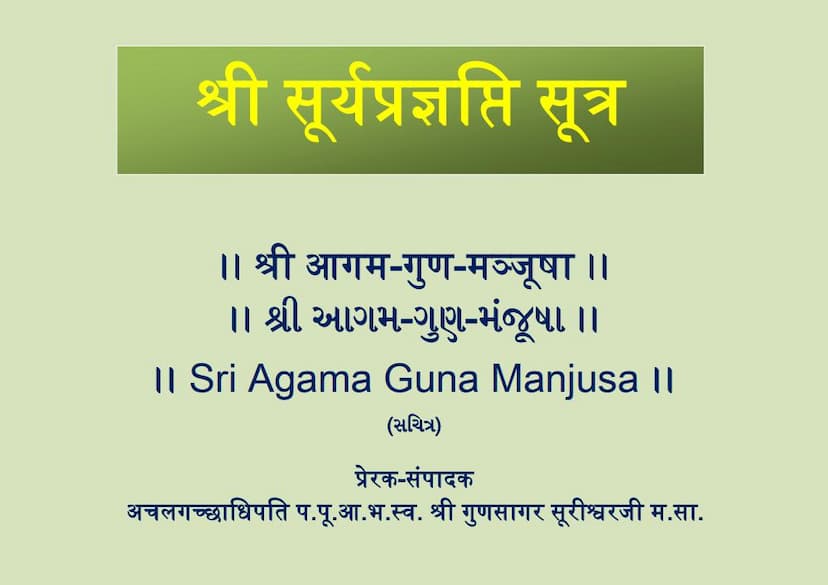Agam 16 Upang 05 Surya Pragnapti Sutra Shwetambar Agam Guna Manjusha
Added to library: September 1, 2025

Summary
Here's a comprehensive summary of the provided Jain text, the "Surya Pragnapti Sutra," based on the translated snippets:
Title: Surya Pragnapti Sutra (Sri Agama Guna Manjusa)
Author/Editor: Achalgachhadhipati P. Pu. A. Bh. Sw. Sri Gunsagar Surishwarji M.Sa. (Presiding Editor)
Publisher: Jina Goyam Guna Sarvoday Trust, Mumbai
Overall Context: This text is part of a larger work titled "Sri Agama Guna Manjusa," which aims to provide a brief introduction to the 45 Agamas (sacred Jain scriptures). The "Surya Pragnapti Sutra" is specifically identified as an Upanga (subsidiary scripture) within the Jain canon. The provided text focuses on the scientific and astronomical aspects described in the Sutra, particularly concerning the Sun. It is presented in Gujarati with some Sanskrit/Prakrit terms and includes detailed explanations of astronomical cycles, movements, and measurements.
Key Topics Covered:
The text delves deeply into the workings of the Sun and its related celestial phenomena, organized into "Prakritas" and "Prabhritas." The main themes include:
-
The Sun's Movement and Position:
- Detailed descriptions of the Sun's oblique motion, its transition between different celestial spheres (mandala), and the resulting variations in day and night length.
- Explanations of the Sun's movement within the northern (uttarayana) and southern (dakshinayana) solstices, including the calculation of specific time periods (murtas) during these movements.
- The text meticulously outlines how the Sun moves from one sphere to another, increasing or decreasing its distance by specific fractional amounts (eg, two units of a sixty-fourth part of a murtra) in relation to the duration of day and night.
- The cyclical nature of the Sun's journey through various spheres over a year (samvatsara) is detailed.
-
Celestial Spheres and Dimensions:
- Descriptions of the Sun's celestial spheres (mandala), their shapes (square, circular, half-circular), and their dimensions (width, length, circumference, and thickness).
- The text provides precise measurements in Yojana (a unit of distance) for these celestial bodies and their paths.
- Discussions on the "Paurushi Chhaya" (shadow cast at a certain time) and its relationship to the Sun's position.
-
The Sun's Luminosity and Heat:
- Explanation of the Sun's heat (tap) and the illuminated areas (udyot kshetra) it covers.
- Discussions on the reflection of sunlight and the presence of darkness.
-
Solar and Lunar Cycles:
- Detailed accounts of the Sun's journey, including its conjunctions with constellations (nakshatras) and the resulting calculations for months and seasons.
- The text outlines the movement of the Moon and its conjunctions with constellations, including the duration of these conjunctions in Murtas.
- The text explains how different constellations are associated with different lunar phases (Purnima, Amavasya) and their respective durations.
- Descriptions of the celestial paths and the durations of their movements.
-
Specific Astronomical Calculations and Concepts:
- Duration of Day and Night: The Sutra details how the duration of day and night varies throughout the year, reaching a maximum of 18 Murtas and a minimum of 12 Murtas.
- Conjunctions: Extensive calculations regarding the conjunctions of the Moon and Sun with various constellations (nakshatras) throughout the year, categorizing them by their position (east, west, etc.) and the number of Murtas they take.
- Specific Years and Cycles: Descriptions of different types of years like Nakshatra Samvatsara, Yuga Samvatsara, Pramana Samvatsara, Lakshana Samvatsara, and Shanisvara Samvatsara, with details on their composition and cycles.
- Celestial Bodies' Positions and Dimensions: Precise calculations of the dimensions and positions of the Sun, Moon, planets, and constellations.
- The Sun's Path: The text specifies the pathways the Sun takes, describing them as being within a certain number of spheres and changing their position by specific increments.
- The Sun's Influence: The text implies the Sun's influence on various aspects of life and the natural world, as indicated by the detailed calculations of its movements and positions.
-
Cosmology and Geography:
- References to Jambu Dwipa, Lavan Samudra, Ghatiki Khanda, Kalodadhi, and Pushkar Dwipa, indicating a broader cosmological framework within which these astronomical descriptions are situated.
- The concept of celestial spheres within these geographical locations is also touched upon.
Methodology and Presentation: The text employs a highly detailed and quantitative approach to astronomical phenomena. It utilizes a structured format, dividing the information into "Prakritas" and "Prabhritas," and often further into specific "Prabhrita Prakritas." The explanations are filled with numerical data, calculations, and specific units of measurement (Yojana, Mūrtra, etc.). The dialogue format, with questions being posed and answered, is evident in parts, suggesting a pedagogical approach.
Significance: The "Surya Pragnapti Sutra" is presented as a highly technical and scientific text within the Jain tradition, focusing on astronomical knowledge. It demonstrates a sophisticated understanding of celestial mechanics, timekeeping, and the movements of celestial bodies, likely used for astrological, calendrical, and perhaps even philosophical purposes within the Jain worldview. The text emphasizes precision in its astronomical calculations and descriptions.